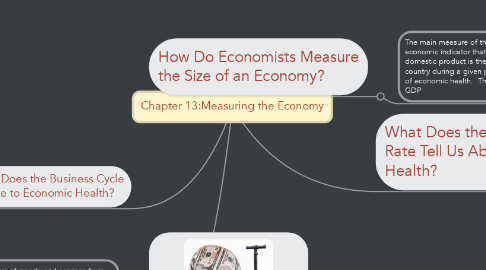Chapter 13:Measuring the Economy
by Annabel DuFault

1. How Do Economists Measure the Size of an Economy?
1.1. The main measure of the size of a nation’s economy is its gross domestic product. GDP is an economic indicator that measures a country’s total economic output. In formal terms, gross domestic product is the market value of all final goods and services produced within a country during a given period of time. A steadily growing GDP is generally considered a sign of economic health. The equation used to measure GDP is as followed: C + I + G + NX = GDP
2. What Does the Inflation Rate Reveal About an Economy's Health?
2.1. The inflation rate is the percentage increase in the average price level of goods and services from one month or year to the next. It is tracked by the same government agency that tracks the unemployment rate, the Bureau of Labor Statistics.In the United States we have come to expect a certain amount of gradual inflation, or creeping inflation, every year.Occasionally inflation goes into overdrive. The result is hyperinflation. Runaway inflation creates extreme uncertainty in an economy. Nobody can predict how high prices will go, and people lose confidence in their currency as a store of value
3. How Does the Business Cycle Relate to Economic Health?
3.1. The business cycle consists of four phases. These phases include a period of growth and a period of decline, as well as the turning points that mark the shift from one period to the next. A period of economic growth is known as an expansion. During this phase of the business cycle, economic activity generally increases from month to month.The point at which an expansion ends marks the peak of the business cycle. At that peak, economic activity has reached its highest level. The peak also marks the start of a decline in economic activity.A contraction is a period of general economic decline marked by a falling GDP and rising unemployment. The lowest point of a contraction is called the trough. Like the peak, the trough marks a turning point. Once the economy hits bottom, a new expansion begins.
4. What Does the Unemployment Rate Tell Us About an Economy's Health?
4.1. The job of tracking unemployment belongs to the Bureau of Labor Statistics. The BLS is a government agency that collects and analyzes economic data. This agency determines the unemployment rate—the percentage of the labor force that is seeking work. Like the GDP, the unemployment rate is a useful indicator of the health of an economy. In general, a high unemployment rate means the overall health of the economy is poor. There are four types of unemployment: Frictional unemployment, structural unemployment, cyclical unemployment, and seasonal unemployment.
4.2. The article focuses on the effects of unemployment. A high unemployment rate means in a weak economy in general and vise versa.


